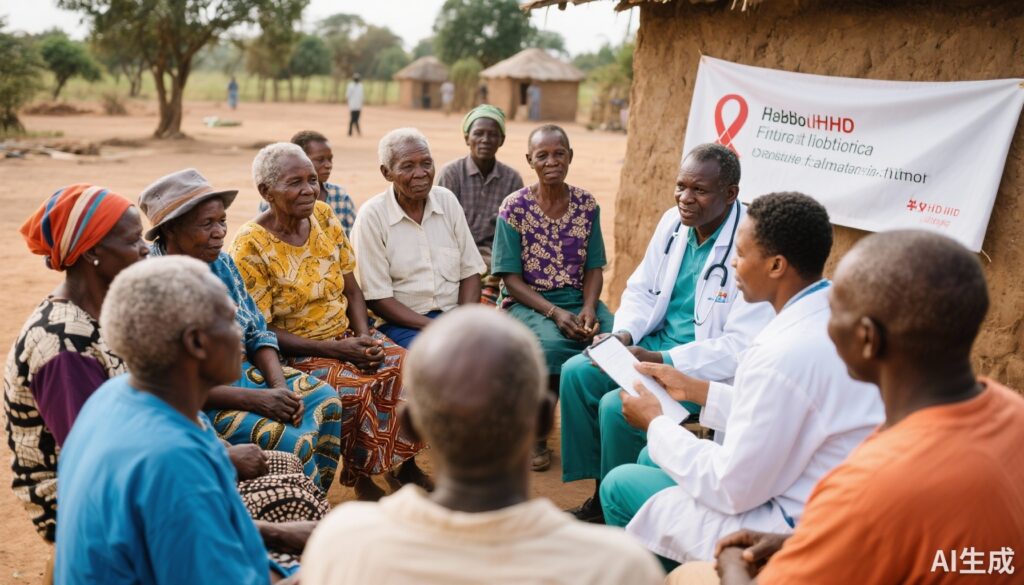Highlight
- HIV prevalence remains substantial among adults aged 40 years and older in sub-Saharan Africa, with higher rates in women and rural populations.
- HIV incidence among older adults, though lower than in younger cohorts, shows significant sociodemographic disparities, notably by education level and residence.
- Antiretroviral therapy (ART) coverage and HIV status awareness improved markedly between study waves, indicating progress but also persistent gaps.
- Tailored public health interventions are essential to address barriers related to age, gender, education, and geography to reduce HIV risk in older adults.
Background: Addressing HIV in Ageing Populations of Sub-Saharan Africa
The demographic landscape of sub-Saharan Africa is transforming, marked by an increasing population of adults aged 50 years and older living with HIV. The widespread use of antiretroviral therapy (ART) has contributed significantly to extending life expectancy in this group, yet data on HIV incidence, prevalence, and treatment outcomes among older adults remain limited. This scarcity of data challenges public health planning and the tailoring of interventions that meet the unique needs of ageing individuals with HIV. The AWI-Gen (Africa Wits-INDEPTH Partnership for Genomic Studies) longitudinal cohort study was designed to bridge this gap by elucidating the epidemiological trends and sociodemographic risk factors influencing HIV acquisition and management in older populations across urban and rural settings in Kenya and South Africa.
Study Design and Methodology
The AWI-Gen study is a multicentre, longitudinal cohort study conducted in four key sites: Nairobi (Kenya) and Soweto, Agincourt, and Dikgale Mamabolo Mothiba (South Africa). It enrolled random community-based samples of adults aged 40-60 years in wave 1 (2013–2016) and adults aged 40 years and older in wave 2 (2019–2022). Participants underwent interviewer-administered questionnaires and structured interviews to collect detailed sociodemographic data. The primary outcome was HIV status, determined at both waves. The study assessed HIV prevalence and incidence, ART coverage, and self-reported HIV status awareness. Logistic regression models were employed to analyze associations between sociodemographic factors and HIV acquisition and treatment outcomes. This robust longitudinal framework enabled evaluation of HIV dynamics and treatment progress over nearly a decade.
Key Findings
Among 7,919 wave 1 participants, 5,730 provided HIV-related data, with women comprising 54.9%. Wave 2 included 5,076 older adults with HIV data, 56.1% of whom were women. HIV prevalence was high: 22.2% in wave 1 and 21.8% in wave 2, but with notable regional variability (p<0.0001) and consistently higher prevalence in women than men (p<0.0001).
Age-specific prevalence peaked among participants aged 40–45 years (26.7%) in wave 1 and 46–50 years (29.9%) in wave 2, declining significantly with advancing age (p<0.0001). The overall HIV incidence rate was 0.35 per 100 person-years (95% CI 0.26–0.48), with a significantly decreased risk of seroconversion observed in the 51–55 years (IRR 0.42; p=0.039) and 56–60 years (IRR 0.19; p=0.0033) age groups.
Education was a potent determinant: participants with no formal education exhibited nearly fourfold higher incidence compared to those with formal education (IRR 0.96 vs. 0.26). Rural residency uniformly predicted greater HIV prevalence in both women and men compared to urban dwellers. Regarding treatment, self-reported awareness of HIV-positive status improved from a low 55.5% in wave 1 to 76.7% in wave 2. ART coverage among those reporting HIV-positive status increased from 90.3% to 94.2%, demonstrating enhanced treatment uptake.
Expert Commentary
The AWI-Gen findings underscore the complex multifactorial influences on HIV epidemiology in older African adults, affirming the persistence of significant HIV burden beyond traditionally targeted younger populations. The inverse relationship between age and HIV incidence aligns with behavioral and biological plausibility, such as diminished sexual activity and immune system considerations in older decades. However, the pronounced risk disparities driven by educational attainment and rural versus urban residence highlight ongoing structural barriers affecting HIV prevention and treatment access.
Although ART coverage is commendably high, the relatively lower HIV status awareness signals continuing gaps in HIV testing, counseling, and stigma reduction efforts, especially among older adults and rural communities. These insights advocate for integrative public health strategies that adapt to the evolving demographic and social realities, including HIV education tailored to older adults, expansion of accessible testing facilities, and gender-sensitive interventions acknowledging women’s disproportionately higher risk.
Limitations include potential self-reporting biases and regional heterogeneities that may affect generalizability across sub-Saharan Africa. Future studies could enrich understanding through integration of virologic and immunologic markers and exploration of comorbidities prevalent in ageing populations that modulate HIV risk and treatment outcomes.
Conclusion
This multicentre longitudinal study provides critical epidemiologic evidence about HIV among older adults in sub-Saharan Africa. HIV prevalence remains notably high with ongoing incidence in the 40–60-year age bracket, emphasizing the necessity for inclusive HIV prevention and treatment strategies beyond younger cohorts. Sociodemographic factors such as education level, gender, and rural residency markedly influence risk and care engagement, underscoring the need for nuanced, equitable health interventions tailored to older adults’ contexts and challenges.
Sustained progress in ART coverage and HIV awareness is promising but falls short of full population-level impact. Policymakers and healthcare providers must leverage these insights to mitigate the continuing HIV burden and improve health outcomes among the ageing HIV-positive population in sub-Saharan Africa.
Funding
This research was funded by the National Human Genome Research Institute and the National Institute of Environmental Health Sciences of the US National Institutes of Health, as well as the Department of Science and Innovation, South Africa.
References
Olubayo LAI, Mathema T, Kabudula C, Micklesfield LK, Mohamed SF, Kisiangani I, Ntimane CB, Choma SS, Houle B, Hazelhurst S, Crowther N, Tollman S, Tluway FD, Ramsay M, Gómez-Olivé FX; AWI-Gen and H3Africa Consortium. The prevalence, incidence, and sociodemographic risk factors of HIV among older adults in sub-Saharan Africa (AWI-Gen): a multicentre, longitudinal cohort study. Lancet Healthy Longev. 2025 Mar;6(3):100690. doi: 10.1016/j.lanhl.2025.100690



